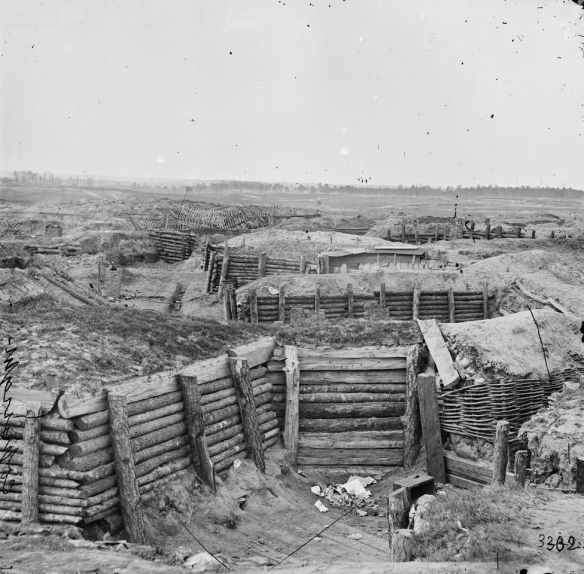Part of the elaborate Confederate works outside Petersburg, after their evacuation in April 1865; such trenches extended for many miles in both directions.
The Crater.
Although referred to as the “siege” of Petersburg, the Union attack against this small southern city was not a full encirclement; rather, it was 10 months of gruelling trench warfare. Two huge armies dug works that eventually snaked for over 30 miles around the city’s eastern and southern fringes, probing for any advantage.
Both Federal and rebel commanders realized early in the Civil War that the more accurate and lethal weaponry available could have a shattering effect upon massed troops. Battles might still be decided by a climactic charge, yet armies routinely dug in whenever in an enemy presence—for protection from an unexpected artillery barrage, if nothing worse. Such tactics were especially true in mid-June 1864 when the Army of the Potomac pressed in upon Petersburg, which was desperately defended by the Army of Northern Virginia. As some 125,000 Union troops crowded into their entrenchments, 55,000 Confederates created such elaborate defenses opposite them that northern newspapers derided Lee as “the Ace of Spades.”
Throughout the winter and spring of 1864–1865, both armies slept in bombproof bunkers. Mortar rounds soared back and forth, snipers killed the unwary, and disease spread amid the cold squalor. Federal regiments attempted breakthroughs at vulnerable spots, almost invariably thrown back with heavy losses. Finally, Petersburg’s defenders collapsed through sheer exhaustion and lack of supplies. Remarkably, almost identical conditions were experienced a half-century later in the fields of Flanders and northern France during the First World War.
JUNE 15, 1864. Petersburg Siege. After stealthily crossing both the Chickahominy and James rivers aboard transports and a 2,200-foot-long pontoon bridge at Windmill Point, the Army of the Potomac’s 15,000-man vanguard under Maj. Gen. William F. “Baldy” Smith of the XVIII Corps surprises the 5,400 Confederates under Beauregard who are holding Petersburg, a small but vital city of 18,000 inhabitants lying south of Richmond. This satellite serves as a hub for five railways, numerous roads, and much river traffic, and the Confederate capital cannot be held should it fall.
Despite quickly building their numbers up to 67,000 men and having ample opportunity over the next five days to overwhelm the now 20,000 defenders, Federal forces fail to carry Petersburg and are even deceived by Beauregard’s feints—which include using logs to simulate additional cannon and lighting excessive campfires at night, all giving a false impression of strength. These tactics nevertheless buy sufficient time for Lee to hasten his main Army of Northern Virginia down to bolster Petersburg’s defenses. Having suffered almost 11,400 casualties in the previous, vain assaults, compared to roughly 4,000 among the defenders, Grant is willing to settle down to protracted trench warfare, pinning the outnumbered Confederates in place.
Coal miners serving in the 48th Pennsylvania Infantry Regiment under Lt. Col. Henry Pleasants attempt to break this stalemate by digging a 511-foot tunnel and detonating an eight-ton charge beneath a Confederate strongpoint known as Elliott’s Salient at dawn of July 30. Although the blast vaporizes some 280–350 defenders and blows a 135-footwide crater, the ensuing Union assault is botched because the specially prepared African American troops from Brig. Gen. Edward Ferrero’s division are replaced at the last minute, for political considerations, by Brig. Gen. James Ledlie’s unrehearsed division. The latter unwittingly blunder into the crater’s soft bottom rather than circle its rim, becoming bogged down, and are easily shot from above when Confederate brigadier general William Mahone’s division recuperates and moves over to plug the gap. A golden opportunity is lost, and some 5,300 Union casualties are suffered through the incompetence of the corps commander, Burnside, who is cashiered. The siege of Petersburg will persist for another eight months until the very final days of the war.
